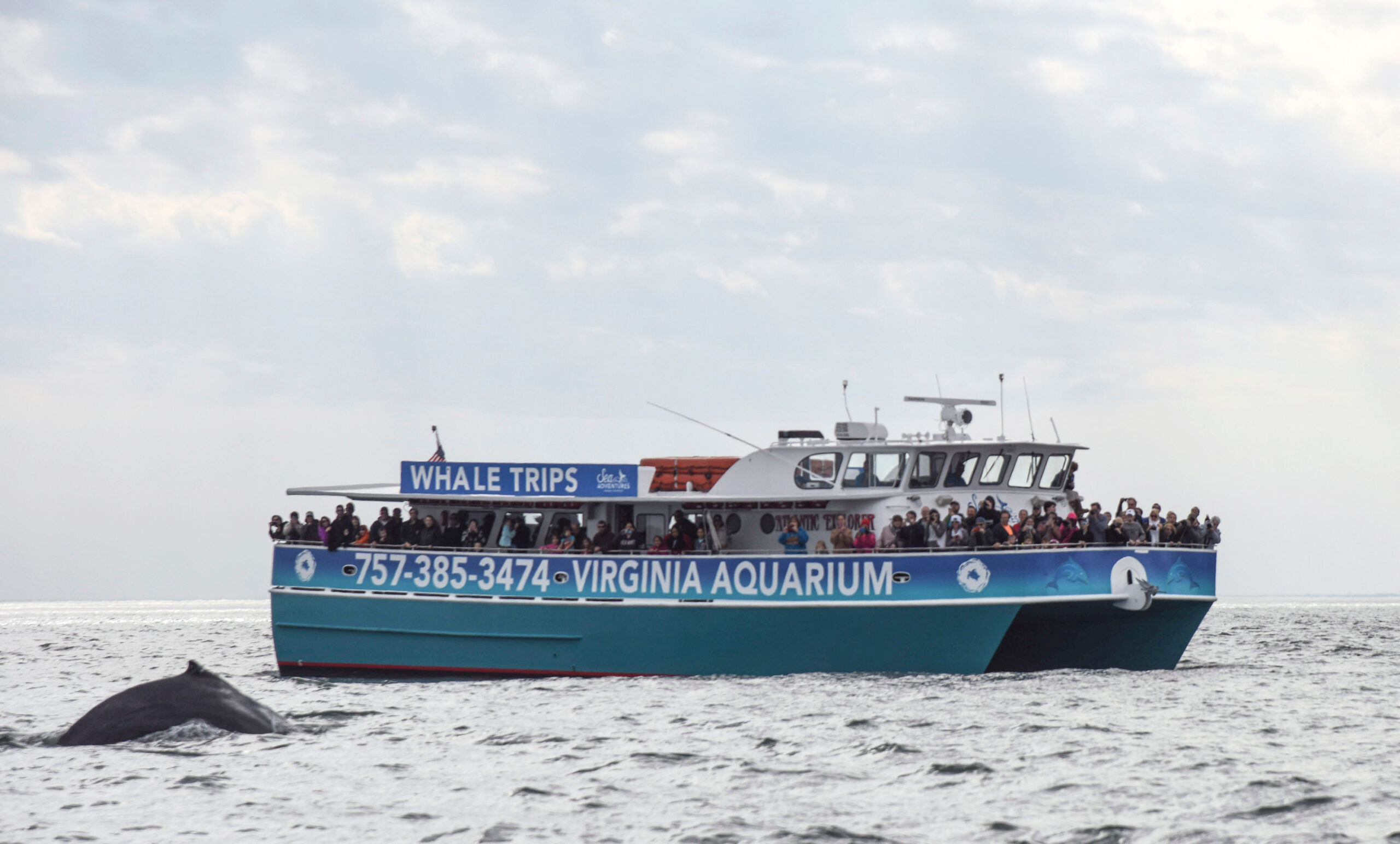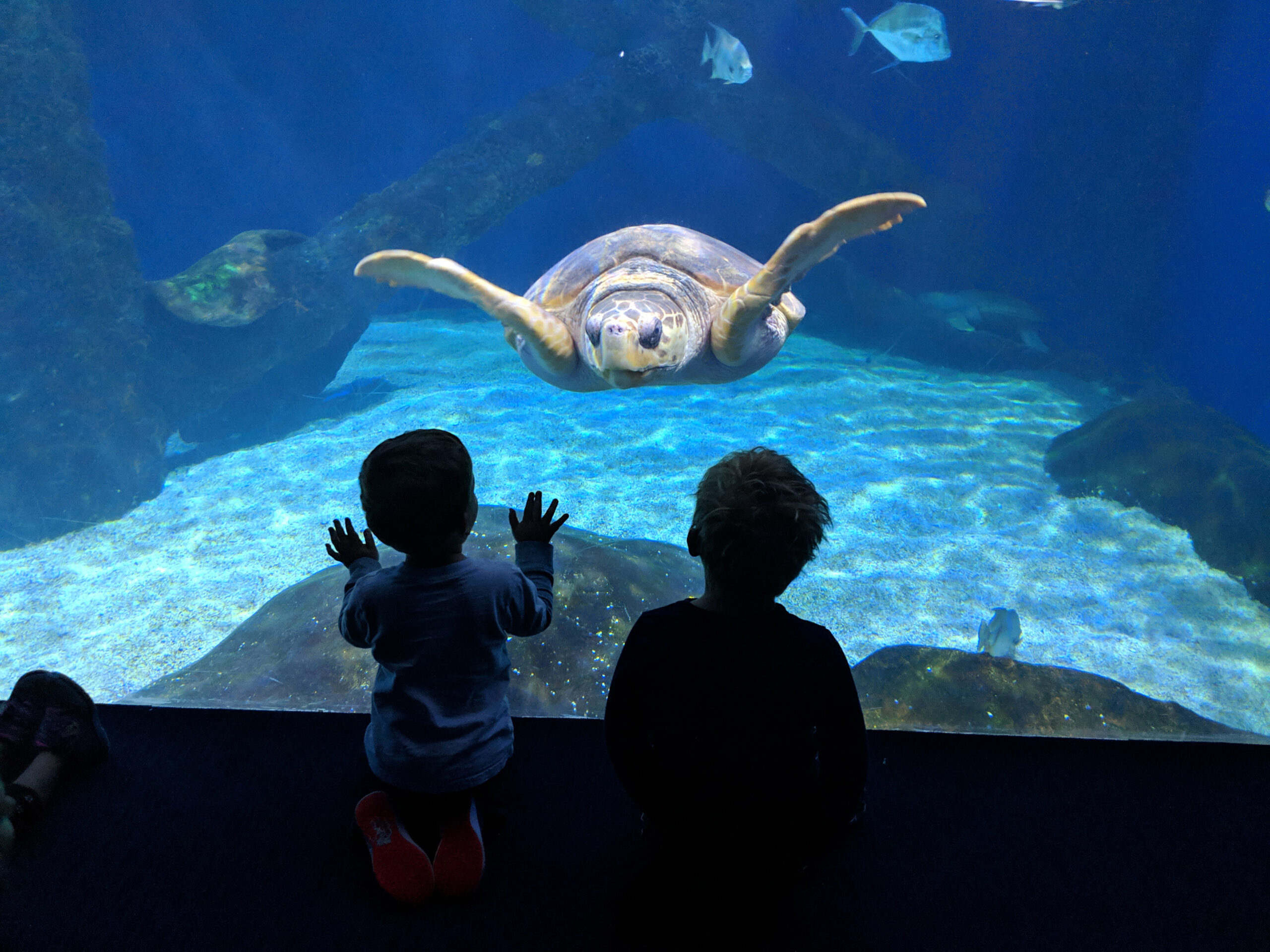The 18 coolest things you’ll see at the Virginia Aquarium
From sharks and rays to VR pods and zip lines, the Virginia Aquarium and Marine Science Center is jam-packed with cool activities for visitors of all ages.
Whether you want to marvel at a massive shark as it glides through a tunnel or spot a playful dolphin during a boat tour, the Virginia Aquarium and Marine Science Center offers an adventure-packed experience unlike any other in the commonwealth.
The aquarium is home to an astonishing array of animals, from Tomistomas and Komodo dragons to spotted eagle rays and harbor seals. Beyond the exhibits, an engaging lineup of immersive virtual reality pods, live veterinary procedures, and outdoor adventures can be found at the aquarium. Here are 18 of the coolest things you’ll find at this must-visit Virginia Beach destination.

Sharks
Sharks that call the aquarium home include the nurse shark, sandbar shark, sand tiger shark, and zebra shark, all of which can be found in the North Building. The lifespans of the sharks range from 24 years for nurse sharks to up to 35 years for sand tiger sharks. Be on the lookout for Mena, the resident zebra shark, who likes to hang out in the sand near the entrance to the tunnel.
Rays
The spotted eagle ray can be found in the North Building. A distant cousin to sharks, the spotted eagle ray can grow up to 16 feet in length with a wingspan of 11 feet and weigh over 500 pounds. Their estimated life expectancy is 25 years. Quite active, they can soar out of the water. Those who want to learn more about the rays can purchase the add-on behind-the-scenes feeding experience. Participants get to help feed the rays and meet the aquarists who take care of them.
Reptiles
A range of reptiles can be found at the aquarium, including green sea turtles, Kemp’s Ridley sea turtles, Komodo dragons, loggerhead sea turtles, timber rattlesnakes, and Tomistomas. Not native to the area, the Tomistoma originates from Southeast Asia. The two Tomistomas that reside at the aquarium are called Ralf and Sommer, both of which came to the aquarium in 2015. Those looking to learn more about Komodo dragons can purchase the add-on behind-the-scenes experience. Participants get to view the feeding process and learn about how the dragons are target-trained. The same behind-the-scenes experience is also offered for sea turtles.
Mammals
While not as plentiful as the sharks and reptiles, two mammals, harbor seals and North American river otters, can be found at the aquarium. The three seals, which can be found in the North Building, are named Hector, Rudder, and Javier. Surprisingly, Hector has been at the aquarium since 2004, having previously lived at SeaWorld. The sole otter, Homer, has called the South Building home since 2011.
Invertebrates
Although not as eye-catching as the other creatures, the aquarium’s invertebrates shouldn’t be overlooked. Both the Atlantic purple sea urchin and knobbed whelk can be found in the North Building. The urchins, which are native to the coasts of the western Atlantic Ocean, can reach 4 inches in length and can live to be 100 or more years old. On the other hand, the whelks only live for 10-15 years but can reach up to a foot or more in length. They can be found along the Atlantic coastline from New England all the way down to Florida.
Cold Water Gallery
Located in the North Building, the Cold Water Gallery contains several species that prefer cold ocean waters, including lionfish and catsharks. There are even interactive exhibits!
Wetlands & Watershed
The Wetlands & Watershed exhibit in the North Building focuses on the biodiversity of the region’s wetlands with a special focus on the Chesapeake Bay. Some of the species found in the exhibit include terrapins, longnose gar, American crow, catfish, and hellbender.
Jellies Gallery
The Jellies Gallery in the South Building is dedicated to jellyfish. It features a variety of jellyfish species at various lifecycle stages. Visitors can even get up close and personal with a moon jellyfish in the touch pool.
Undersea Super Powers Gallery
The South Building’s Undersea Super Powers Gallery allows kids to learn about the superheroes of the seas with a focus on how they can adapt to avoid predators, find a mate, and feed themselves.
Our Watershed
The interactive Our Watershed exhibit in the South Building allows kids to have fun while learning about the area’s watershed. The play area focuses on the animals that call the watershed home, how the water cycle works, and ways they can contribute to the health of the watershed.
Windows Into Animal Care
The South Building’s Windows Into Animal Care allows kids to assume the role of a veterinarian or field biologist by watching staff members care for the aquarium’s animals through windows.
Dolphins, while on a boat tour
The aquarium offers dolphin-watching boat tours on two vessels, the Atlantic Explorer, a 100-passenger catamaran, and the Atlantic Scout, a 39-passenger low-riding inflatable boat. Although the tours primarily focus on spotting bottlenose dolphins, seabirds and sea turtles are also often spotted. The aquarium also offers whale-watching tours during the winter months.
Virtual reality pods
General admission tickets for the virtual reality pods are $8. The museum describes them as being fully immersive, which provides sounds and movements that make it feel as though you’re deep underwater. The experience focuses on a pod of bottlenose dolphins as they explore a coral reef.
Divers
Visitors should keep an eye out for divers in the large aquariums. On occasion, the divers perform maintenance duties in the tanks. For details about what the divers are working on, find a nearby aquarium educator.
Veterinary exams
Although exams aren’t offered every day, some visitors may be able to watch staff veterinarians perform medical exams and procedures on some of the residents of the aquarium through the observation window of the Veterinary Clinic.
Water Quality Lab
The aquarium’s Water Quality Lab, which has approval from the Commonwealth of Virginia’s Department of Environmental Quality, is set up to process water samples from citizens interested in monitoring the water quality of their local waterways, including estuaries, rivers, creeks, and stormwater retention ponds. Water chemistry and bacteria panels are two of the common tests that are run. Once samples have been dropped off at the lab, results will be mailed within three business days.
Owl Creek Landing
Owl Creek Landing is an experience in and of itself. Located just behind one of the aquarium buildings, the 38-acre recreational forest is home to a large spiral tower that has the longest steel slide in the country. It also has a large canopy walk and a treehouse playground, making it the perfect place for energetic kids to burn off some steam.
The Adventure Park
Keep the outdoor fun going with The Adventure Park at Virginia Aquarium. The nearby park offers a range of activities, including 17 treetop trails, 258 challenge elements, and 33 ziplines. There are six different challenge levels, and it’s designed for those aged 5 and above. General admission tickets start at $42 for those 5-6 and go up to $64 for adults.



